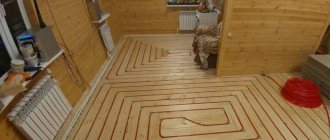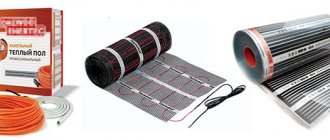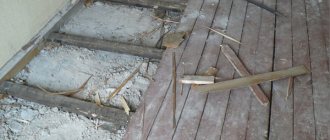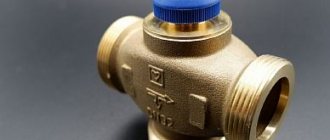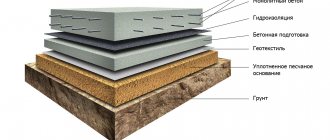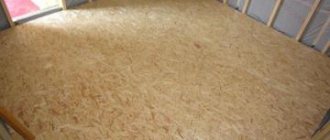A tile floor has its own important advantages: it copes well with moisture, can withstand significant mechanical loads, is not exposed to aggressive chemicals, and can perform its functions for decades. It can be made even more comfortable if you use a warm floor under the tiles. In order to choose the right option, you need to know the features of various floor heating technologies.
Laying heated tiles Source manesu.com
Features of using tiles
Using tiles is very convenient, but for all its advantages it has several disadvantages:
- If moisture gets on the surface, the tiles can easily slip.
- The floor is cold and walking on it is then uncomfortable.
The latter circumstance is especially evident during the winter period.
The first of these disadvantages can be overcome by choosing tiles with a special surface. In the second case, the problem can be solved, but for this it will be necessary to install a warm floor.
Advantages
- We can say that all such products are certified in accordance with European standards. In particular, self-extinguishing raw materials are used in production.
- The high density of expanded polystyrene provides increased strength, so thermal insulation boards do not change their original dimensions.
- Another important difference is that it is equipped with special clamps - they allow you to easily and quickly install a floor heating pipe system.
- Installation of heating pipes is carried out according to installation markings applied in a special way to the surface. This allows heat to be effectively distributed throughout the room.
- Both “wet” and semi-dry screeds can be laid on such a coating with equal success.
Features of underfloor heating
There are two types of heated floors:
- using water heating;
- electric.
In the first case, the solution is more economical in operation - after installing the heated floor, it can be connected to the existing heating system. However, installing such a heated floor is a more complex and expensive procedure compared to the second option.
Heating a tiled floor can be considered as an additional heating system in an apartment.
Laying a concrete screed Source narobraz.ru
Laying scheme
The electric heating cable is heated evenly along its entire length, so it is laid in a snake with a step of 10–15 cm between turns. In this case, the main task is to distribute the cable evenly over the entire area of the floor base. When planning and drawing up a cable layout, the following aspects are taken into account:
- The heating cable should not be laid under plumbing equipment and furniture, as heat transfer will be impaired. The exception is attachments that do not have contact with the floor.
- The distance from heating pipes and heating devices is about 20 cm, from the walls 10 cm.
Layout of heating cable in the bathroom.
How to choose the right system
In order to decide which warm floor for tiles is best to choose, you need to determine your preferences. To do this, you need to take into account the following:
- Since we are talking about installing a heating system, it is necessary to determine what power it should have. Can be used as the only or additional heating unit in the house. In these cases, power requirements will vary.
- You need to decide how much you need to use the screed. Although it provides reliable protection for heating elements, in some cases it can create additional inconvenience. There are alternative options for making the top layer of the floor.
- When analyzing the situation, you need to take into account the type of room. in which the installation will take place. In a city apartment there are more restrictions to choose from compared to a private house.
- You need to decide what level of costs the owner can afford. In this case, it is necessary to consider not only the cost of the installation, but also how much it will cost to operate.
Methods for laying a water floor Source bg.aviarydecor.com
If the house uses tiles for the floor, then installing heating under it will not only warm up the apartment better, but also make it possible to walk on it without fear of freezing. The latter is especially important when it comes to the bathroom.
When thinking about how to choose a heated floor, you need to try to ensure that the system can be repaired at minimal cost.
About water heated floors
It is a pipe system through which heated coolant circulates. The pipeline is located between the base of the floor and the top covering. Water is used as a coolant. It can be taken from the heating system, or special equipment can be used for heating. As the water passes through the pipes, it gradually cools, so in such systems it is not recommended to use pipes that are too long. During installation, metal or polymer pipes are usually used. When choosing them, reliability and durability play an important role, because in the event of a leak, complex and expensive repairs will have to be performed.
The water floor is connected to the heating Source rmnt.mirtesen.ru
The operation of such floors is relatively economical. Their use makes it possible to reduce energy consumption. This value in different cases can be 20-60% depending on the specific situation. The coolant temperature during operation does not exceed 50-60 degrees.
The installation is quite complicated and requires the participation of specialists. The water heated floor is a multi-layer structure. When installing them, it is necessary to ensure high-quality thermal insulation so that the heat does not escape outside the home.
If a heated floor is installed in a residential building that was left for several days during frost, then there is a danger that the liquid in the pipes may freeze. To prevent this from happening, the system is left turned on for this time at a reduced coolant temperature or liquid is pumped out of the pipes during absence.
Installation of a water floor Source my-climate.com.ua
Cable heated floors
In this case, the heating element is an electrical cable. After laying it, a cement screed is made. When using this option, its thickness will be minimal - no more than 5 centimeters. This floor heating option is considered one of the easiest to install. To operate such a system, it is enough to use 220 volt power. During operation, a power of 80-150 watts is consumed per square meter of area. However, if the wiring in the house is old. then before installing this system it must be changed to a more reliable one.
Such devices are easy to operate and highly reliable. It is believed that cable heated floors can operate without failure for 50 years or longer. There was a recorded case where such a system worked for 62 years and was in fully operational condition at the time of replacement. It was dismantled due to deterioration of the coating.
Installation of a thermomat Source folksland.net
Use of special heating mats
This coating is an improved version of cable coating. In this case, the wire with which the heating will be carried out is attached to a special mesh. Usually its length is 50 and its thickness is 30 centimeters. This improvement significantly simplifies and speeds up installation of the system. When installing heated floors, it is recommended to avoid areas where heavy furniture will subsequently stand.
Single or double wires are used for heating mats. In the first case, this reduces the price, and in the second, it increases the reliability of the equipment used. Such mats have a thickness of 3 millimeters, so their installation does not lead to a significant rise in the floor.
When creating a warm floor under tiles, this type is very convenient due to its low thickness and ease of installation.
Film heating Source education-web.ru
See also: Catalog of companies that specialize in insulating country houses.
Film heating system
This principle of operation of a heated floor is based on the fact that the film warms up thanks to infrared radiation. When the rays hit opaque objects, they release thermal energy. At the same time, the floor covering is heated. The temperature of parts that emit energy does not increase during operation, which allows you to spend less energy on heating.
When the heating rods are turned on, it causes the flooring to heat up. As a result, the air near the floor is heated to the greatest extent. Temperatures decrease as altitude increases. The effect of infrared rays will become invisible at a height of 2-2.5 meters. A 4 mm thick film is used as a heating element, on which graphite strips are applied. As soon as the temperature reaches a certain limit, the sensor is triggered and temporarily turns off the current. The intensity of work can be adjusted using thermocouples.
Electric heated floor Source prodomostroy.ru
When controlling the operation of such heated floors, electronic control can be used, which allows you to set the desired operating mode for a long time. It is interesting to note that during operation of the system in question, electromagnetic radiation is generated. However, it is very weak and cannot harm human health.
Application of electric water heating
In recent years, another type of underfloor heating has gained popularity, in which both electric heating and coolant circulating through pipes are used to generate heat. This type of heating uses pipes that are made of structured polyethylene. Their diameter is two centimeters. Antifreeze is used as a coolant in the pipes. A chromium-nickel electrical cable is laid parallel to them, which is in a sheath made of Teflon. Pipes and cables are covered with concrete screed. If a leak occurs, a clearly visible stain will appear on the floor surface, which will allow you to accurately determine the location of the breakdown and take action.
Installation diagram Source pronyr.ru
The cable warms up the antifreeze, which circulates through the pipes. As a result of the heat, the liquid quickly boils, which leads to rapid heating of the floor.
An important feature of this type of heated floors is that electrical energy during their operation is consumed efficiently and at the same time economically. This system has good resistance to overheating, which allows it to be installed in the right places, including under massive furniture.
What type of heating should you choose?
Heating mats, water and electric water floors are best suited for tiles. The cable system option is worth considering if you have the skills to install such floors yourself or you can order such a service for a reasonable price. It is worth remembering that problems may arise with diagnosing and repairing breakdowns.
A water floor is a relatively cheap heating option. If it is possible to connect the heating circuit to a gas boiler, you can provide economical floor heating. If you have to use electricity, it is better to give preference to an electric-water system
Film infrared floors are considered the worst solution, despite their efficiency and cost-effectiveness. They are perfect for installation under laminate, but do not “get along” well with tiles. Experts advise choosing a different, more practical heating option.
Features of electric heated floors
When comparing the two types of heating, the following advantages of this solution can be noted:
- After the water heating pipes are laid, a concrete screed must be made. It can significantly raise the floor level, which is inconvenient if the installation takes place in a city apartment. In addition, its weight increases. In a private home this can become a problem in some cases.
- The installation procedure for electric heated floors is easier than for water floor heating.
- Regulating the power supply for electric heating elements is easier than performing the same steps for a water floor.
Preparing the screed Source winplast.ru
Electric floor installation
When choosing which electric heated floor is best for tiles, you need to decide which option will be preferable: using a heating cable or thermomats.
In the first case, laying such a floor under the tiles will be a cheaper option. However, calculating the cable length, determining the layout and installation will require significant effort. When laying the cable, the concrete screed will be larger than when using thermomats.
Using heating mats is a simpler process. In this case, the cable is already attached to the fiberglass mesh, which makes it possible to lay it while maintaining the required distance between the wires. In practice, to use this method, it is enough to determine the area and shape of the room and purchase a roll of the required size.
To install heated floors under tiles, you need to do the following:
Film heating element Source mfmpsu.ru
Preparatory work
Before proceeding with installation, it is necessary to remove the previous floor surface and clean the surface of debris. It is important to pay attention to how level the floor is. If potholes and small rises are visible on it, then you will need to carry out a rough screed, leveling the surface before laying thermomats.
Heating power calculation
Before connecting the heated floor, you need to calculate the power needed to heat the apartment. To do this, you need to decide whether the warm floor is the main or additional heating system. In the first case, it is necessary that each square meter provide 140-180 watts of power. In the second case, the required value will be lower. Now it will be 80-140 watts for the same area.
Pipe laying must be thought out in advance Source publika.md
Counting the number and power of mats
First you need to decide on the power of the mats, and then calculate their number. Since tiles are installed mainly in the bathroom and kitchen, it is worth taking the indicators for these rooms as a guide:
- average power for the kitchen – 110-130 W/m2;
- the average power for a bath, shower and toilet is 120-150 W/m2.
These indicators are relevant only if the heated floor is installed as an auxiliary heating system. If the electric floor is designed to thoroughly heat a kitchen or bathroom, the power of one mat should be at least 140-180 W/m2.
Next, we calculate the usable area of the room - multiply the length of the room by the width and subtract the area that household appliances will occupy.
Now you can calculate the number of mats - divide the usable area by the area of one element of the selected power.
Video description
About calculating the power of a heated floor in this video:
Create a schema
Before you begin directly laying an electric heated floor under the tiles, you need to imagine how the mats will be located. To do this, you need to draw up an appropriate diagram. In it you need not only to mark the location of the heating wires, but also to set the laying step for them.
Laying a water floor Source yar-limb.ru
When planning, the following must be taken into account:
- Necessary. so that the distance from the wire to the walls is not less than 10 centimeters.
- You need to first think about where massive furniture without legs or household appliances will stand. It is not recommended to lay a heated floor in this place due to the fact that the heat will practically not escape outside and will cause overheating of the wires.
- When determining how the wires will lie, it is not necessary to ensure that they are strictly parallel. If necessary, the mesh can be cut and the cable placed at an angle.
The location of the heating elements must be made taking into account the required power, which has been previously calculated.
Connecting heating pipes Source rmnt.mirtesen.ru
Checking the electrical wiring
For reliable operation of electric heating, it is necessary to ensure high-quality and reliable operation of the electrical wiring. It is necessary that the cable cross-section corresponds to the power that will be spent on an electric heated floor. If this is not the case, then an appropriate replacement must be made. You also need to check whether the switches can handle this current load and, if necessary, they will need to be replaced.
Thermal insulation
It is necessary to ensure that the heat from warming up does not go down. To do this, you need to lay out a thermal insulation layer. One effective way is to lay penofol. This is a self-adhesive surface with a foil layer. It is recommended to stick damper tape around the perimeter of the walls. which is designed to compensate for thermal expansion of the coating. A metal mesh is placed on top. This is necessary so that there is no direct contact between the heating elements and thermal insulation.
Tiles are glued to thermomats Source dekormyhome.ru
Calculation of heating cable length
The length of the electrical cable will depend on the total power of the system. It is calculated by multiplying the average power (W/m2) by the total area of the room; it is also recommended to add a reserve of 30% for heat loss. Here you can focus on the optimal indicators for the kitchen and bathroom described above.
Then we determine the type and rated power per linear meter of cable - it can vary from 10 to 60 W/m. Next, we divide the total power of the system by the power of the linear meter of cable - we get the length.
Thus, it is obvious that the more powerful the heating cable is chosen, the less of it will be needed for installing the electric floor.
Video description
About the features of laying heated floors on thermal insulation in the video below:
Control and management
In order to receive information about the degree of heating of the heated floor, it is necessary to install a temperature sensor. For it, a groove is made in the wall from the thermostat vertically downwards, then passes along the floor. The sensor must be placed in a corrugated pipe that is laid in such a way that it ends at the temperature control point.
A thermostat is used to control the heating mode. It is installed on the wall next to the outlet. With its help, you can set the desired operating mode for the heated floor.
Checking electrical parameters
Before installation, it is necessary to check how accurately the resistance of the thermomat corresponds to the value stated in the description. An accuracy of 10% is considered acceptable. This can be done using a multimeter.
Water heated floor Source boyargo.ru
Laying the heating layer
If a cable is being installed, it is convenient to attach it using mounting tape. When installed on top of the mesh, the wires can be secured to it using plastic cable ties. It is enough to arrange the thermomats according to a pre-drawn diagram and after that the heated floor is connected to the thermostat. After installation is completed, another measurement of the wire resistance is carried out. It must match the one received earlier.
Now, how to connect the thermostat:
- First, remove the decorative frame.
- The power supply is connected to the In socket, taking into account the polarity.
- The wire from the heated floor is connected to the Out input.
- The temperature sensor must be connected to the Censor.
After this, the thermostat will be in working order.
Screed
To fill it, prepare a cement mortar. It should include: sand, cement, crushed stone, water in a ratio of 4:1:5:0.6. It is also necessary to add 1% plasticizer to the mixture. The thickness of the screed should be 3-5 centimeters. It must be remembered that the cement mixture will dry completely after 4 weeks.
The tiles must be installed very carefully Source rmnt.ru
Laying tiles
After the screed has dried, apply a layer of tile adhesive on top. You can do this in 2-3 days. If a thermomat is used, the glue can be placed directly on the mats without installing a screed. After this, the tiles are laid.
Installing a thermomat Source teplospec.com
Recommendations from experts
You can build a warm floor yourself. It is preferable, of course, to have at least basic knowledge in this area. After all, for example, the same infrared film requires proper connection. Although some systems are easier to deal with.
Regardless of whether the floors are made with your own hands or workers are invited to do this, there are a number of tips that will help carry out all the work efficiently. So:
- you need to understand that not the entire floor will be heated, but only those areas where there is no furniture or other interior items - approximately 60-75% of the total area of the room, which means that the material is purchased at exactly these percentages;
- before laying tiles, you need to double-check the serviceability of the system, especially if mats were installed (they may be twisted, broken, or even have breaks);
- after all the elements are put in place, you need to “ring” and double-check the joints of each section of the floors - it is cheaper to fix the damage before the finishing coating is installed than to then make repairs not only at your place, but also at those of your neighbors below;
- Under no circumstances should you walk on laid heating mats or place or throw any heavy objects on them until the tiles are laid;
- if the repair is not yet completed, then you need to mark the “path” of all cables, so that in the future it doesn’t happen that when drilling walls (for example, under shelves), you get into a wire;
- if a cable floor is being installed, you can turn it on for testing only after the screed has completely dried (drying time depends on the mixture);
- when working with infrared film, it is imperative to use a substrate with heat-reflecting properties - experts recommend using a rolled technical cork (2mm thick);
- before fixing the infrared film, you must first lay the mounting fiberglass mesh (mesh size - up to 3cm);
- to select the power of the thermostat, you need to carry out the following calculations - 150 multiplied by sq.m. heated area;
- for convenient operation and repair (if such a need arises in the future), it is recommended to use installation cables of different colors;
- if the infrared heating system outputs more than 2W, then you need to use a connection through a special machine.
These tips were compiled by professionals, which means they are tested by experience. Therefore, if you plan to create really high-quality heating, then you should listen to them.
